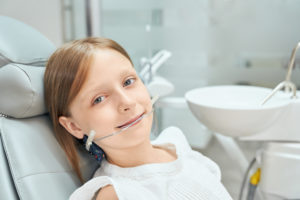
Maintaining a proper bite has important health benefits that go beyond physical appearance. A good bite promotes overall oral health and can prevent problems in chewing, headaches, even gum disease and tooth decay.
That’s why dentists must treat bite maladjustments in children as soon as the procedure can be done safely. But for parents, some of the signs of biting problems in their children can be hard to discern. Here are some common signs and conditions children have that may indicate the need to address a misaligned bite.
Common signs of poor bite in children
- Overbite or deep bite. Overbite is a condition in which the upper teeth conceal the lower teeth when the child tries to close their mouth. This can also manifest if the child bites the roof of their mouth with their lower teeth.
- Underbite. Predictably, an underbite is just the opposite: The lower teeth cover up the upper teeth when the child closes their jaw.
- Open bite. This occurs when the upper and lower sets of teeth don’t meet precisely in front of the mouth when the child’s mouth closes. Open bite is similar to overbite and underbite but to a smaller degree.
- Crossbite. In a crossbite, one or some of the child’s frontmost upper teeth sit behind the lower teeth, while the others rest outside of the lower teeth as they normally should.
- Excessive spacing. Especially when your child still has their primary teeth, sizable spaces between their front teeth may be indicative of a bite problem.
- Overjet. Commonly referred to as “buck teeth,” overjet refers to a condition in which the front incisors protrude or stick out over the lower set.
- Abnormal tooth eruption. When new, permanent teeth grow in a child’s mouth, they’re supposed to do so in certain defined patterns or steps. If disrupted, these new teeth may run up against each other as they emerge, as both attempt to occupy the same small space on the gums.
- Facial imbalance. Sometimes a bite issue can manifest by shifting a child’s facial bones or chin over to one side. Facial imbalance can be detected when observing the child from some distance away.
- Headaches or earaches. Incorrect bite motions can create excessive pressure on gum muscles or membranes in the ear. This can result in telltale head or ear pain in the child.
- Habit development. Thumb sucking, mouth breathing, odd swallowing practices, or teeth-grinding can be signs that your child needs to have their bite corrected. They may also develop issues or problems with eating or speaking.
- Gum disease or tooth decay. In some cases, untreated bite problems can contribute to more advanced conditions, such as gingivitis or cavities.
How a dentist may correct your child’s bite problems
Your dental professional can determine the extent of your child’s bite issues using x-rays and teeth impressions. These tools can show the areas of misalignment in clear detail.
If more advanced treatment is needed, your dentist may suggest at least one of these courses of action:
Mouth implements. Many bite problems are resolved over the long term with the help of fixed braces or removable retainers. Both appliances gradually straighten and align the teeth over a certain amount of time.
Removal of teeth. If your child still has their baby teeth, they may be impeding the arrival of new teeth and would have to be taken out. In older children, a dentist may deem it necessary to take out some adult teeth to correct the bite.
Jaw surgery. Especially if the child’s bite issues are affecting their oral bone structure, your dentist may decide that more extensive surgery on their jaw is necessary.

